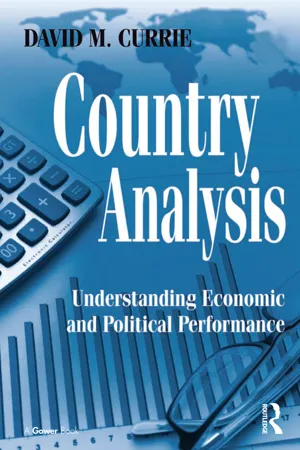Economics
Appreciation and Depreciation
Appreciation and depreciation refer to changes in the value of assets or currencies over time. Appreciation occurs when the value of an asset or currency increases, while depreciation occurs when the value decreases. These terms are commonly used in economics to describe the fluctuation of prices and exchange rates in financial markets.
Written by Perlego with AI-assistance
Related key terms
2 Key excerpts on "Appreciation and Depreciation"
- eBook - ePub
Country Analysis
Understanding Economic and Political Performance
- David M. Currie(Author)
- 2016(Publication Date)
- Routledge(Publisher)
It’s not because we’re buying euros that we know to multiply or divide by the exchange rate, it is the way the exchange rate is quoted. There is no universal rule that you always multiply or always divide by the currency quote, and it doesn’t make any difference whether you’re buying or selling. It all depends on how the exchange rate is quoted. All you have to do is make up a few examples using various prices, try exchange rates quoted in both directions, and practice them a few hundred times. Pretty soon it will become second nature. That’s the advantage that many foreigners have over us Americans – they exchange currencies constantly, most of us do it only occasionally.Appreciation and Depreciation
Now let’s examine the other currency exchange: when we receive 1,000,000 euros from the Treasury of France in three months, we must sell those euros for dollars (another way of saying the same thing is that we must use the euros we receive to buy dollars). The difficulty is that we don’t know now what will be the value of the euro in three months. Currencies constantly change value as factors in the currency markets fluctuate. Political situations, economic indicators, balance of payments, and market psychology are never constant, and exchange rates reflect the fluctuation. We are exposed to currency risk or exchange risk : the risk that one currency will exchange for a different amount of another currency.When a currency increases in value, the currency is said to appreciate. Appreciation means the currency is worth more of another currency. If you own it, you can sell it for more of another currency. If you don’t own it and need to buy it, you’ll have to pay more for it than before it appreciated. It’s just the opposite with depreciation , which means that the currency is worth less of another currency. If you own it, you can’t sell it for as much of another currency. If you don’t own it, you can buy it at a lower price than previously. Appreciation and Depreciation occur within seconds on the currency market, although you and I don’t notice it until we look at quotes on television or in the newspaper, or until we go abroad and see them in action. Box 8.1 - eBook - ePub
- James P. Neelankavil, Anoop Rai(Authors)
- 2014(Publication Date)
- Routledge(Publisher)
A forward rate is the rate for the purchase or sale of a foreign currency for delivery at a future date. For example, a trader agrees to purchase €100,000 from another dealer for a price agreed upon today, for delivery to take place in three months. No money is exchanged today. At the end of three months, both traders are obligated to deliver as promised. In every other feature, the forward rate is similar to the spot rate. The most common periods for forward currencies are 30-, 60-, and 90-day deliveries.APPRECIATION AND DEPRECIATION OF CURRENCIES
In all competitive markets, prices play an important role in equating supply and demand for any product. If prices increase, demand for the commodity declines and supply of the commodity increases, resulting in a new equilibrium price. In the short run, price changes can cause disruptions in the production of output and services, while in the long run, demand and production will adjust to the new price levels.To understand the effects of price increases and price decreases of foreign currencies, it is first necessary to formally define currency Appreciation and Depreciation. If the price of the euro increases, that is, moves from US$1.20 / € to US$1.25 / € to US$1.30 / €, the dollar is said to be depreciating, or, conversely, the euro is said to be appreciating. If the price of the euro decreases, that is, moves from US$1.20 / € to US$1.15 / € to US$1.10 / €, the dollar is said to be appreciating, or, conversely, the euro is said to be depreciating. One way to remember the difference is based on whether the buyer has to pay more or less for a currency. Paying more implies hardship and therefore can be associated with a depreciation of the currency. If an American pays less for a foreign currency, one can consider that as good news and recognize that the dollar has appreciated.A depreciating dollar is a boon to an American exporter, because it reduces the effective price to the foreign buyer of American commodities. To illustrate: Assume the current or spot price of the euro is US$1.20 / €. Assume the price of a candy bar in the United States is US$1.20. Assume the price of a candy bar in Germany is €1. Assume now the dollar depreciates drastically (for illustration purposes) to US$2.40 / €. A German can now purchase two candy bars from the United States for €1. Thus, whenever the dollar depreciates, U.S. goods become cheaper for German importers and exports will increase from the United States.
Learn about this page
Index pages curate the most relevant extracts from our library of academic textbooks. They’ve been created using an in-house natural language model (NLM), each adding context and meaning to key research topics.

